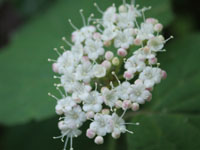![]()
Mapleleaf Viburnum is a species of shrub in the honeysuckle family native to eastern North America from southwestern Quebec and Ontario south to northern Florida and eastern Texas. Landscape architects and designers have often recommended it for shady, dry locations for several decades, but it is only sold at a few very large, diverse nurseries or specialty native plant nurseries; and is not generally well known in the landscaping trade or with homeowners. The scientific and common names refer to the superficial similarity of the leaves to those of some species of maple trees; the plant is occasionally mistaken for young maples, but is readily distinguished by the flowers and fruit; the viburnum produces small, purple berries, while maples produce dry, winged seeds.
![]()
There is currently no commerical application of mapleleaf viburnum.
![]() Within the realm of naturopathic medicine and folklore, mapleleaf viburnum can be used as an antispasmodic and astringent. An infusion of the crushed inner bark has been used in the treatment of dysentery and has also been used as a purgative. A decoction of the stems has been used in the treatment of coughs and sore throats. A poultice of the chewed, unopened flower buds has been applied to lip sores. A decoction of the roots has been used to treat sickness associated with teething.
Within the realm of naturopathic medicine and folklore, mapleleaf viburnum can be used as an antispasmodic and astringent. An infusion of the crushed inner bark has been used in the treatment of dysentery and has also been used as a purgative. A decoction of the stems has been used in the treatment of coughs and sore throats. A poultice of the chewed, unopened flower buds has been applied to lip sores. A decoction of the roots has been used to treat sickness associated with teething.
Please note that MIROFOSS does not suggest in any way that plants should be used in place of proper medical and psychological care. This information is provided here as a reference only.
![]()
No edibility information has been provided about mapleleaf viburnum.
Please note that MIROFOSS can not take any responsibility for any adverse effects from the consumption of plant species which are found in the wild. This information is provided here as a reference only.
![]()
Mapleleaf Viburnum grows in the shrub layer of moist hardwood forests. Suitable for: light (sandy), medium (loamy) and heavy (clay) soils and can grow in heavy clay soil. Suitable pH: acid, neutral and basic (alkaline) soils. It can grow in semi-shade (light woodland) or no shade. It prefers moist soil and is known to be resistent to animal foraging.
| Soil Conditions | |
| Soil Moisture | |
| Sunlight | |
| Notes: |
![]()
Mapleleaf Viburnum is a deciduous shrub which can grow 100cm to 200cm tall. The leaves are in opposite pairs, 5cm to 10cm long with three to five lobes which are similar to a maple tree. Each leaf has a serrated margin, and the leaf surface has a fuzzy texture. There is a diverse manifestation of autumn colour with this species from pale yellow to bright yellow to orange or pink, rose, or red-purple depending on the light exposure and weather conditions. The flowers are white with five small petals, produced in terminal cymes 4cm to 8cm in diameter. The fruit is a small red to purple-black drupe 4mm to 8mm long. It attracts butterflies and birds. Mapleleaf Viburnum is a larval host to the Celastrina ladon butterfly.
![]()
| Plant Height | 100cm to 200cm | 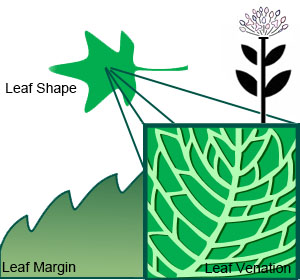 |
| Habitat | Moist Hardwood Forests | |
| Leaves | Palmate | |
| Leaf Margin | Serrate | |
| Leaf Venation | Cross-venulate | |
| Stems | Small woody stems | |
| Flowering Season | May to August | |
| Flower Type | Rounded clusters | |
| Flower Colour | White | |
| Pollination | Insects | |
| Flower Gender | Flowers are hermaphrodite and the plants are self-fertile | |
| Fruit | Small drupe seeds | |
| USDA Zone | 4A (-31.7°C to -34.4°C) cold weather limit |
![]()
The following health hazards should be noted when handling or choosing a location to mapleleaf viburnum:
 |
TOXIC Consumption of large quantities of mapleleaf viburnum fruit is considered to be toxic. |
![]()
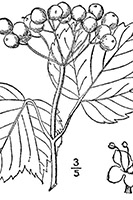 |
-Click here- or on the thumbnail image to see an artist rendering, from The United States Department of Agriculture, of mapleleaf veiburnum. (This image will open in a new browser tab) |
![]()
 |
-Click here- or on the thumbnail image to see a magnified view, from The United States Department of Agriculture, of the seeds created by the mapleleaf viburnum plant for propagation. (This image will open in a new browser tab) |
![]()
Mapleleaf Viburnum can be referenced in certain current and historical texts under the following four names:
Mapleleaf Viburnum can be translated into the following select languages:
| Arabic | Bulgarian | Chinese (Sim) | |||
| Croatian | Czech | Danish | |||
| Dutch | Esperanto | Estonian | |||
| Finnish | French | German | Ahornblatt Viburnum | ||
| Greek | Hebrew | ומאלף ויברנום | Hungarian | ||
| Italian | Japanese | メープルリーフ・ビバヌム | Korean | 메이플 리프 비 부르 눔 | |
| Punjabi | ਮੈਪਲੇਲਿਫ਼ ਵਿਬਰਨਮ | Lithuanian | Norwegian | ||
| Persian | Polish | Portuguese | |||
| Romanian | Russian | Клещевая кабина | Slovak | ||
| Spanish | Swedish | Tagalog | |||
| Turkish | Ukrainian | Карплеф Віспур | Vietnamese |
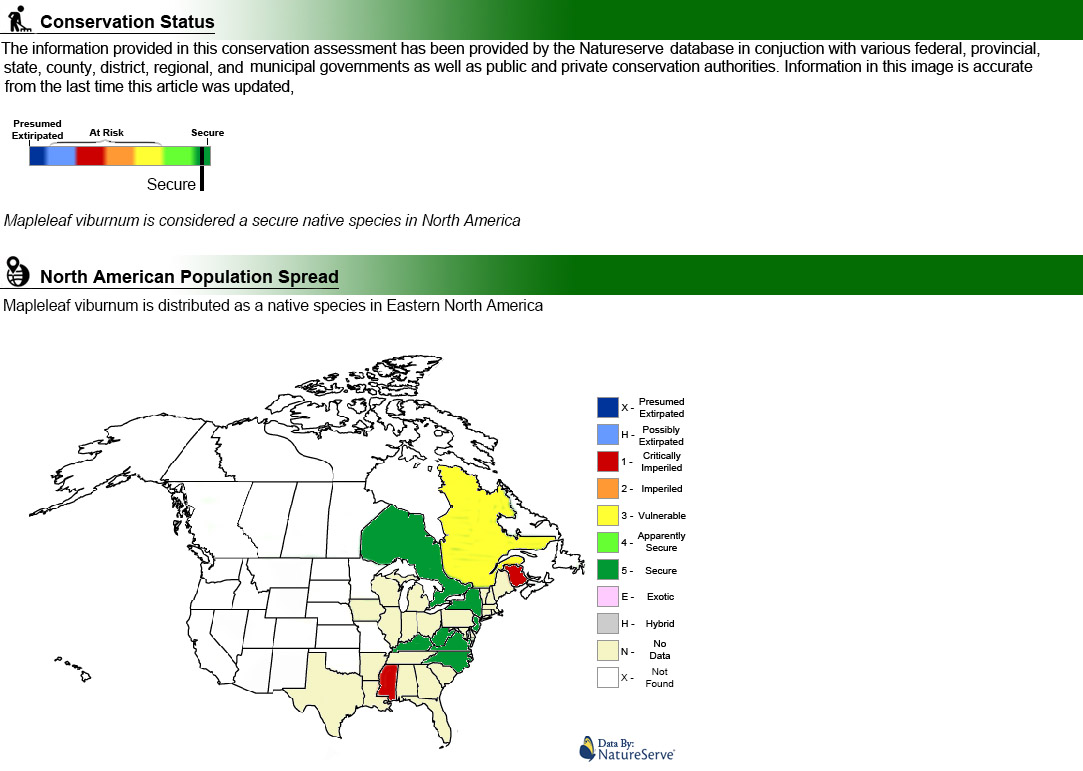
![]()
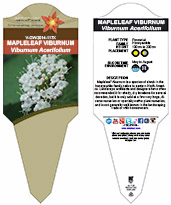 |
The MIROFOSS database offers free printable garden tags for personal and non-profit use. These tags can be used to properly identify plant samples in a garden. Click on the tags shown on the the screen or -click here- to download a full size jpeg image for a mapleleaf viburnum identification tag; which can be printed on paper or used with a plastic laser printer. |
 |
What's this? What can I do with it? |
![]()
| Background | Dickinson, R.; Royer, F.; (2014) Plants of Southern Ontario. ISBN 978-1-55105-906-8 |
| Background | Gardening with Native Plants of the South (Reprint Edition) (2009) Wasowski, S. with A. Wasowski |
| Biology | Dickinson, T.; Metsger, D.; Bull, J.; & Dickinson, R. (2004) ROM Field Guide to Wildflowers of Ontario, Royal Ontario Museum, Toronto:McClelland and Stewart Ltd. |
| Environment | National Audubon Society. Field Guide To Wildflowers (Eastern Region): Alfred A. Knopf. ISBN 0-375-40232-2 |
| Physical Identification | National Audubon Society. Field Guide To Wildflowers (Eastern Region): Alfred A. Knopf. ISBN 0-375-40232-2 |
| March 18, 2018 | The last time this page was updated |
| ©2025 MIROFOSS™ Foundation | |
 |
|

